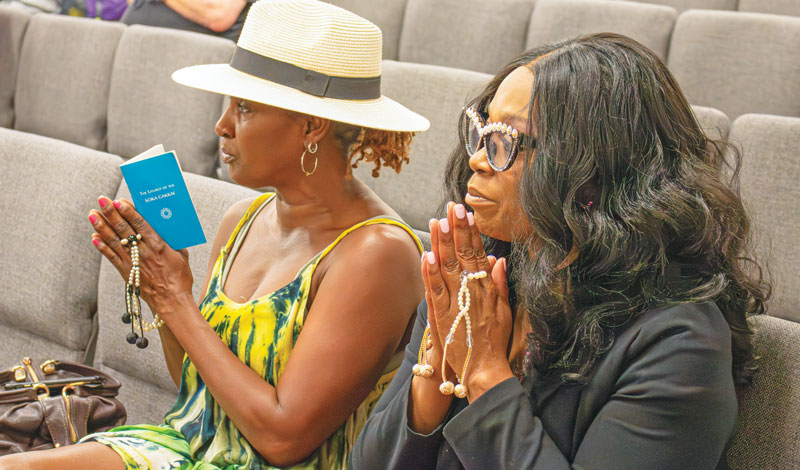Gongyo—which includes reciting portions of the “Expedient Means” and “Life Span of the Thus Come One” chapters of the Lotus Sutra morning and evening—is part of daily practice for Nichiren Buddhists. This series carries Ikeda Sensei’s explanations of gongyo, section by section. The full text can be found in The Heart of the Lotus Sutra, pp. 127–41.
Ikeda Sensei:
To begin with, just what does the “Life Span” chapter teach? It explains the eternity of life. The chapter’s Japanese title, nyorai juryo, means to fathom the span of life (juryo) of the Thus Come One, or the Buddha (nyorai). The “Life Span” chapter clarifies that the life span of the Buddha is immeasurable.
Shakyamuni explains the eternity of life in terms of his own existence. This is important. The eternity of life is not in any sense an abstract theory, nor is it fictitious or imaginary. The “Life Span” chapter is an account of Shakyamuni’s own experience.
The gist of this account is as follows: Shakyamuni begins by noting that most people believe that he renounced the world at a young age and practiced and attained Buddhahood beneath the bodhi tree near the city of Gaya. But he refutes this view and clarifies that in fact he attained Buddhahood in the inconceivably remote past and that ever since then he has been instructing countless people in this saha world and in innumerable other lands. In this way, he indicates that his life span is immeasurable and that his life itself is eternal and nonperishing.
Now, some may wonder: “Although we say that Shakyamuni’s life is eternal, didn’t he in fact die? Doesn’t this indicate that the Buddha’s life span is finite?” This is a very natural question. We can find an answer in the “Life Span” chapter itself.
The chapter explains that the Shakyamuni who attained enlightenment for the first time in India is a provisional, or “expedient,” Buddha, whereas the Shakyamuni who attained enlightenment in the remote past and whose life is eternal and nonperishing is a true Buddha.
An expedient, as we have already learned, is a means that the Buddha employs to guide people. While the life of the Buddha is in fact eternal, the Buddha appears in a transitory form and then “enters extinction” as a means to develop people’s seeking spirit. This is the answer that the “Life Span” chapter provides.
While accepting the eternity of the Buddha’s life, some may question if this revelation has any significance for the lives of us ordinary people. It has a very important bearing, for the Buddha who attained enlightenment in the remote past ultimately is none other than us, the ordinary people who embrace the Mystic Law.
Nichiren Daishonin says, “The term ‘Thus Come One’ refers to all living beings” (The Record of the Orally Transmitted Teachings, p. 124). Eternity is not an attribute exclusively of the Buddha’s life; it is the true aspect of the lives of all living beings. …
Who Will Spread This Teaching in the Latter Day of the Law?
Even within the Lotus Sutra, the teaching that can save the people of the Latter Day of the Law can be found only in the “Life Span” chapter. Overcoming the sufferings of birth and death means gaining liberation from the fundamental sufferings of existence. This is the teaching that enables people to develop a state of happiness arising from the very depths of their being. The “Life Span” chapter elucidates the eternal life from which all lives fundamentally spring.
What benefit may be gained from hearing the “Life Span” chapter expounded? In “Distinctions in Benefits,” the 17th chapter, we find the passage “Hearing that the Buddha’s life is immeasurable, all beings are filled with joy” (The Lotus Sutra and Its Opening and Closing Sutras, p. 278). In other words, understanding life’s eternity fills people with joy from the depths of their being. This joy is the power of the Mystic Law to dispel any suffering, no matter how deep-seated.
Needless to say, this refers to the benefit of Nam-myoho-renge-kyo hidden in the chapter’s depths; Nichiren Daishonin states, “Nam-myoho-renge-kyo is the greatest of all joys” (OTT, 212).
Second Soka Gakkai President Josei Toda described the inner state of those who embrace the Gohonzon, saying, “From the depths of their lives, they feel total peace of mind, and to live is itself a joy.”
Nam-myoho-renge-kyo is the great Law that illuminates the lives of all people. It is the great beneficial medicine that can fundamentally save all people of the Latter Day, who are steeped in the sufferings of birth and death.
The protagonists of the Lotus Sutra who will teach and spread the great beneficial medicine of Nam-myoho-renge-kyo among the people of the Latter Day are none other than the Bodhisattvas of the Earth.
You are reading {{ meterCount }} of {{ meterMax }} free premium articles

